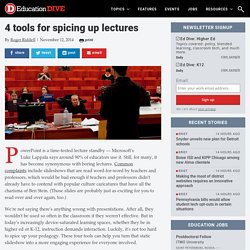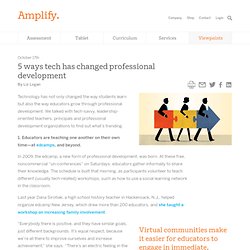

4 tools for spicing up lectures. PowerPoint is a time-tested lecture standby — Microsoft's Luke Lappala says around 90% of educators use it.

Still, for many, it has become synonymous with boring lectures. Common complaints include slideshows that are read word-for-word by teachers and professors, which would be bad enough if teachers and professors didn't already have to contend with popular culture caricatures that have all the charisma of Ben Stein. (Those slides are probably just as exciting for you to read over and over again, too.) We're not saying there's anything wrong with presentations. After all, they wouldn't be used so often in the classroom if they weren't effective. Microsoft Office Mix Who says you can't teach an old dog new tricks? Display Note Speaking of interactive presentations, Display Note allows an instructor to deliver presentations wirelessly via an iPad or Android device. SlideDog Splashtop Splashtop offers two products for the classroom: Mirroring 360 and Classroom.
EdTech: 100 Tech Tools for Teachers and Students. This post is #12 in DailyTekk’s famous Top 100 series which explores the best startups, gadgets, apps, websites and services in a given category.

Total items listed: 104. Time to compile: 8+ hours. Follow @DailyTekk on Twitter to make sure you don’t miss a week! This post is quite a departure from last week’s subject: 100 Tools to Develop the Next Killer iOS or Android App. Our normal audience may not get much out of this week’s roundup but don’t worry, I’ll be back with something you can use next week! So here’s what I’ve got for all you educators our there: some random and cool EduTech tools, tech tools ... There’s more to this article! Free Technology for Teachers: ISTE: What It Is and How It Changed My Life. A Teacher's Guide to Social Media. How Do I Get into Education Technology? When I first started teaching fifth grade science at KIPP Academy in Houston, Texas, I had no idea that I would end up parlaying that experience into my current role as a consultant to education technology companies.

I was simply a teacher on a mission to do right by my students, and that drive just happened to coincide with an inclination towards figuring out how to use technology to solve problems. Looking back, however, I realize that I took some steps that other teachers who are interested in getting into technology can absolutely replicate.
I also took quite a few missteps that I hope I can help others avoid. So here's a guide on how teachers can get into education technology, written in partnership with four other educator-entrepreneurs who have found their own unique way to combine their love for education with their love for technology. Education technology companies need educators. Technical: Business: How do you build a budget? Operational: 10 Twitter Tools Used by Social Media Experts. With so many Twitter tools out there, it’s hard to know which ones to trust with your Twitter account management.

So why not take a look at what the social media and industry experts are using! Here are ten Twitter applications and tools used by some of the top Twitterers. The following list is presented in alphabetical order: Bit.ly Bit.ly is just a URL shortening service right? Buffer Buffer is deemed the smarter way to tweet, and is used by @tweetsmarter, @jaybaer, and @askaaronlee. CoTweet CoTweet, used by @nealschaffer, @chrispirillo, and @emarketer, is considered a Twitter marketing tool for companies who want to engage, track, and analyze conversations about their brand. HootSuite HootSuite is one of my personal favorites as far as Twitter management is concerned, and is also quite popular amongst the social media elite including @chrisbrogan, @tweetsmarter, and @tamar. Paper.li SocialOomph Triberr.
Center for Media & Social Impact. 5 ways tech has changed professional development. Technology has not only changed the way students learn but also the way educators grow through professional development.

We talked with tech-savvy, leadership-oriented teachers, principals and professional development organizations to find out what’s trending. 1. Educators are teaching one another on their own time—at edcamps, and beyond. In 2009, the edcamp, a new form of professional development, was born. At these free, noncommercial “un-conferences” on Saturdays, educators gather informally to share their knowledge. Last year Dana Sirotiak, a high school history teacher in Hackensack, N.J., helped organize edcamp New Jersey, which drew more than 200 educators, and she taught a workshop on increasing family involvement. Virtual communities make it easier for educators to engage in immediate, specific and focused conversations with their peers. “Everybody there is positive, and they have similar goals, just different backgrounds. 2. 3. 4. 5. “It’s not a power job,” Mazza says. Kevinhoneycutt.org.
Buzz Garwood.